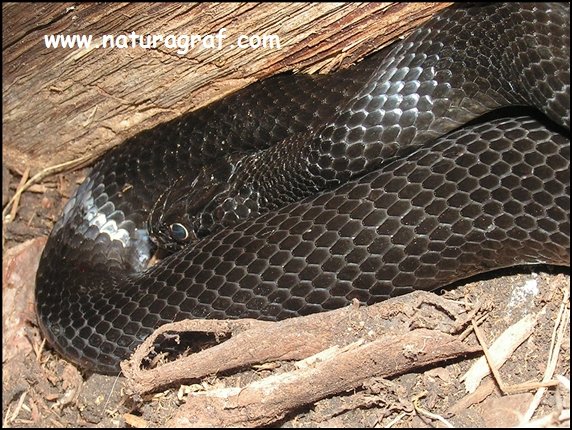|
|
Crna
poljarica |
Hierophis
viridiflavus
|
Western Whip Snake |
|
|||
|
|
|
|
|||||
|
GDJE: Istra i Kvarner, Primorje, neki otoci (Krk, Veli Brijun, Susak, Palagruža...). Najviši nalaz u RH je u Lici (Krasno, 1340 m), a najjužniji je kod Baške Oštarije. |
Opis: |
Description: |
WHERE: Istria and Kvarner, Primorje, some islands (Krk, Veli Brijun, Susak, Palagruža...). The highest record for Croatia is from Lika (Krasno, 1340 m), and the southernmost is near Baške Oštarije.
|
||||
|
|
Ljuske: Obično 19 (17-21) preko sredine leđa, trbušne: 187-212 (m)/197-227 (?, 92-125 para podrepnih. |
Scale count: Usually 19 (17-21) accross mid-body, belly: 187-212 (m)/197-227 (f), 92-125 pairs beneath the tail. |
|||||
|
Stanište: Voli raznovrsna suha staništa, otvorena, ali dobro obrasla vegetacijom (npr. osunčane kamene padine, grmasta područja, makija i garig, rijetke šume i njihove granice, ostaci građevina i vrtovi). Povremeno i vlažne livade i druga vlažna mjesta. U RH do 1340 m. |
Habitat: Likes a variety of dry habitats, open, but well vegetated (i.e.- sunny rocky slopes, bushy areas, maccia & scrub, open woods and their edges, ruins & gardens). Sometimes also humid meadows and other humid places. In Cro up to 1340 m. |
||||||
|
Ponašanje: Nekad vrlo česta, većinom aktivna danju, boravi na zemlji, ali se doro penje po grmlju i kamenju. Hibernira u pukotinama u kamenju, hodnicima sisavaca, nekad u grupi. Od mjesta hibernacije se može u proljeće vrlo daleko preseliti do ljetne "kuće". Tu može boraviti na relativno malom području (oko 3000 m2 u djelovima Italije). U tom teritoriju kreću se u potrazi za hranom, sunčaju se, vrući dio dana provode u sjeni. Slično je i s riđovkom. Vjeruje se da tamnija koloracija nekih jedinki pospješuje upijanje topline za hladnijeg vremena i te jedinke znadu narasti nešto veće od ostalih i imaju više jaja. Ali te prednosti se uravnoteže s tim da predatori češće ulove takve jedinke jer nisu dovoljno kamuflirane. Vrlo brza (odmah iza zmajura) i okretna zmija, lovi vidom i znade biti vrlo agresivna ako ju se ulovi i znade uporno i jako gristi. Ponekad davi plijen. |
Behaviour: Frequently very abundant and largely diurnal and terrestrial, although it climbs well among rocks and in bushes. Hibernates in rock cracks, mammal burrows, sometimes communally. May move quite a long distance in spring from the hibernating shelter to its "summer" house. Here it may spend most of its time in a relatively limited area (arround 3 000 m2 in parts of Italy). In that territory they move in search of food, bask, they spend the hotter part of the day in shade. As with the Adder, it is believed that the black coloration increases the heat absorption in cool weather and animals tend to grow slightly larger than others and produce rather more eggs. However, these advantages are balanced by such animals often being poorly camouflaged and consequently probably more prone to predation. This snake is fast (second only to the Montpelier Snake) and agile, hunting by sight. Extremely agressive if caught, it tends to bite hard and persistently. May sometimes constrict prey. |
||||||
|
Prehrana: Prehranjuje se gušterima, sisavcima, ptićima, drugim zmijama (čak i ljutice i pripadnici vlastite vrste!), žabama. Mladi se prehranjuju malim gušterima i njihovim jajima, velikim skakavcima. |
Food: Feeds mainly on lizards and a varying proportion of mammals, also some nestling birds, other snakes (even Vipers and members of its own species!) and frogs. Juveniles feed mainly on small lizards and their eggs and large grasshoppers. |
||||||
|
Razmnožavanje: Mužjaci se bore u sezoni parenja, "bičuju" se svojim repovima i traže partnera do 3 km. Ženke lijegu 4-15 izduženih jaja (često 4-7 u Italiji) koja su 30-40 mm x 15-22 mm sa zvijezdastim uzorcima. Mladi se izlegu za 6-8 tjedana (20-25 cm). |
Reproduction: Males fight in the breeding season, lashing at each other with their tails and will exceptionally travel up to 3 km searching for mates. Females lay 4-15 (often 4-7 in Italy) elongated eggs that are about 30-40 x 15-22 mm with star-shaped concretions on the shell. Juveniles hatch out in arround 6-8 weeks (20-25 cm). |
||||||
